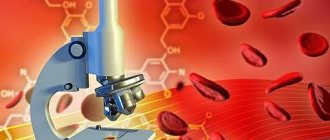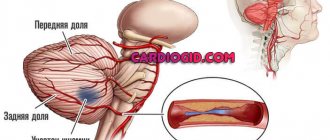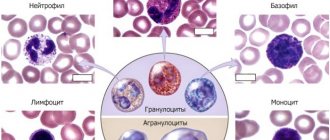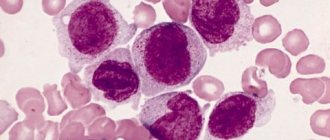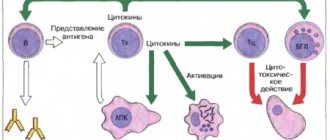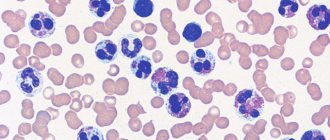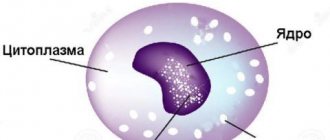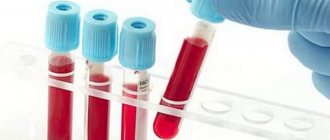What is antithrombin III in a blood test?
Anticoagulant antithrombin III
This indicator refers to the primary plasma anticoagulants and is the main component of the body’s anticoagulant system, that is, it helps maintain blood in a liquid state and prevents the formation of blood clots.
The anticoagulant activity of plasma depends on a number of indicators: antithromboplastins, antithrombins, factors that prevent the self-assembly and maturation of fibrin. The activity of antithrombin III accounts for 75% of the activity of the entire anticoagulant system as a whole. Antithrombin III is the main plasma cofactor of heparin; it is capable of inactivating a number of plasma coagulation factors (thrombin, X, IX, VII, XII factors). Inactivation of thrombin occurs when it irreversibly binds to AT III in the presence of heparin.
Clinical laboratory test for antithrombin III
The Antithrombin 3 indicator is the basic index of the hemostasiogram technique.
Using this method, all components of the hemostatic system are determined:
- Prothrombin time;
- APTT index;
- Thrombin time index;
- Quantitative indicator of fibrinogen in plasma;
- Assessment of RKFM activity;
- The level of operation of the anticoagulant system is antithrombin index 3;
- D-dimer;
- Glu index in analysis;
- Indicators of proteins C and S.
Indications and contraindications for the test
Thrombophlebitis - indication for the test
Indications:
- recurrent thrombotic and thromboembolic pathologies in any forms and manifestations (acute coronary syndrome, acute cerebrovascular accident, pulmonary embolism, disseminated intravascular coagulation syndrome, thrombophlebitis);
- symptoms of worsening blood clotting (increased bleeding of the gums, frequent and profuse nasal, gastric (with ulcers), uterine bleeding, tendency to form subcutaneous hematomas, etc.);
- suspicion of a hereditary deficiency of this factor;
- long-term use of anticoagulants to prevent thromboembolism.
Contraindications. There are no absolute contraindications to this study. A relative contraindication is an inflammatory process in the area of venipuncture.
Correction and therapy of the level of antibodies to thyroglobulin
Treatment is prescribed by an endocrinologist depending on the diagnosis. If a tumor is suspected, a biopsy and additional examination are required.
Problems with hormone production not only affect the quality of life, but can also affect the human reproductive system. Women planning motherhood or pregnant women should be careful about hormonal imbalances.
An integrated approach to health improvement, in addition to medical prescriptions, must include a healthy diet, lack of physical overload, and a stable mental state.
Preparing and administering the test
Biological material - venous blood
Venous blood is required for the analysis. Blood is taken from a vein under sterile conditions in the treatment room by a nurse. It is advisable to take blood in the morning after an eight-hour overnight fast, but if this condition cannot be met, it is possible to take plasma for analysis at any time of the day, three to four hours after a meal. Before this manipulation, you should also not drink tea, coffee, carbonated drinks, alcohol, or smoke. It is allowed to drink clean water without gas in moderate quantities.
Two to three days before the study, it is necessary to exclude heavy mental and physical stress, since they can also affect the synthetic function of the liver, and, accordingly, the production of AT III.
Description
The site of antithrombin III synthesis is the liver and the inner wall of blood vessels or the endothelium. By structure, it is a two-component protein found in plasma. The formed elements or blood cells do not stick together thanks to this substance so that the blood remains liquid. This is the primary coagulation factor, which is constantly present in the blood and controls its fluid state, its level does not depend on whether clot formation is currently required or not.
If a blood vessel is damaged, a coagulation cascade or sequence of biochemical reactions is activated, leading to the closure of the wound by a thrombus and stopping the bleeding...
AT III controls this process; at its “command,” the formation of a blood clot stops. The clot that is formed is exactly what is required to block the wound lumen - no more and no less. AT III irreversibly binds the main protein that forms clots - thrombin. Thrombin forms a framework on which the clot collects. Without this framework, thrombus synthesis is impossible.
Self-binding occurs slowly and increases gradually. If you add heparin, the binding of thrombin accelerates significantly. Therefore, AT III has a different name - a cofactor or “accelerator” of heparin. Antithrombin III consists of two functional parts - one part irreversibly binds heparin, the other inhibits it or restrains it.
If the AT III level is low, then the person is at risk of thrombosis. Antithrombin III deficiency can be congenital or acquired. In the congenital form, thrombosis occurs already at the age of 20-30 years, which causes heart attacks and strokes.
More often, deficiency of this substance is acquired; there are two forms. In one case, AT III has a normal structure, but its amount is insufficient. In the other, the quantity is normal, but the structure is defective, which is why the substance cannot perform its function.
This indicator is used to judge the capabilities and resources of the blood anticoagulation system; it is an obligatory component of the coagulogram.
The main manifestation of AT III deficiency is thrombosis that occurs in the arteries and veins of various organs. An elevated level of this indicator indicates a risk of bleeding.
In pregnant women, the coagulation system works intensively; their normal values differ from those of healthy people.
Read completely
Antithrombin III - 400 rub.
Urgent analysis - 800 rub.
Deadlines
Normal – 1 day.
Urgent – 1.5 – 2 hours.
Taking blood from a vein is paid separately - 300 rubles.
(If several tests are performed simultaneously, the service for collecting biomaterial is paid once)
Indications
- selection of treatment for the prevention of thrombosis in bedridden patients
- preparation for surgery
- pregnancy and preparation for childbirth
- injuries of various organs
- venous thrombosis
- control of anticoagulant treatment
- abnormal menstrual bleeding
- acute phase of viral hepatitis
- vitamin K deficiency
Material for analysis
Blood plasma (citrate). The material must be delivered to the laboratory within 2 hours from the moment of blood collection or frozen at a temperature of -20 degrees C
Preparing for the study
The material is venous blood, which is taken in the morning on an empty stomach after a night break in food from 8 to 14 hours. The day before blood sampling, you should not overexert yourself physically or drink alcohol. Drinking water is not limited. In urgent cases, blood sampling is allowed 4 hours after eating.
Factors influencing the result
Errors in diet are the reason for incorrect results
Three groups of factors can influence the result:
- improper preparation of the patient (non-compliance with diet, severe stress);
- errors in manipulation, blood collection technique, storage conditions and transportation to the laboratory;
- some physiological and pathological conditions that are sometimes ignored when interpreting results (menstruation, pregnancy, prematurity).
Normal AT III values
Antithrombin III levels vary for children and adults
The norms of the indicator depend significantly on age.
The range of AT III values in an adult (17-18 years or more) is wide, it ranges from 75 to 125%. In different laboratories, reference values may differ slightly from each other, this is due to different errors of the equipment used, therefore, when the laboratory report indicates the norms of 80-128% or 85-130%, the conclusion can be trusted.
In adolescence (12-16 years) this interval is narrower, on average from 80 to 120%.
For children from one year to 11 years, the range of values is maximum, from 80 to 140%.
Newborns (1 year of life) have low AT III levels. Typically the factor value ranges from 40 to 80%. In premature infants, the lower limit may be even lower (25-30%), this is due to immaturity and functional failure of the liver.
Pregnant women are characterized by high variability of the indicator. In the first and second trimester it is close to normal (80-120%) or increased to 130-140%, but not higher. In the third trimester it usually drops to 60-100%, but not lower.
Increased level of AT III
Diseases of the pancreas as a cause of increased rates
As a rule, this change indicates reduced blood plasma clotting. In some cases, this is relatively beneficial, for example, in patients who have suffered an acute myocardial infarction, since the risk of repeated thromboembolism in their case can result in severe disability or death. However, a pronounced increase in the level of AT III can also be a dangerous condition; it poses a high risk of hemorrhagic complications, for example, in patients with chronic gastric and duodenal ulcers, varicose veins of the esophagus, hemorrhoids, etc.
An increase in the value of antithrombin III is possible in several cases.
- Pathology of the hepatobiliary system.
- Acute hepatitis of viral or alcoholic etiology leads to temporary changes in the synthetic function of the liver. There may be an increase in the formation of AT III and a decrease in the production of coagulation factors, but, as a rule, these fluctuations stop during the period of remission.
- Pathology of the gallbladder and bile ducts can also lead to stagnation of bile (cholestasis) and liver damage, so it is worth promptly identifying such pathologies as: chronic calculous cholecystitis, opisthorchiasis, chronic cholangitis, tumors of the gallbladder and head of the pancreas.
- Treatment with anticoagulants. Indirect anticoagulants (warfarin, neodicoumarin) inhibit the formation of vitamin K-dependent coagulation factors (II, VII, IX, X) in the liver, thus they reduce the coagulation of blood plasma without the help of antithrombin III, which increases its concentration in the plasma.
- Vitamin K deficiency. Vitamin K stimulates the formation of coagulation factors, including prothrombin (the precursor of thrombin), accordingly, the lack of prothrombin does not provide AT III with a sufficient amount of substrate for neutralization, and the level of AT III in plasma increases.
- Severe inflammatory processes of any localization.
Taking anticoagulants increases antithrombin III levels
Markers of autoimmune diseases
Autoimmune diseases that develop due to excessive synthesis of antibodies can be recognized at the initial stage and their development into a chronic form can be prevented.
An increase in aggressive immunoglobulins in the circulatory system may remain a temporary autoimmune reaction if the cause of the endocrine system disorder is identified and eliminated in a timely manner.
One such marker is AT TG. It allows you to determine the presence of a malfunction and observe how the body reacts to the prescribed treatment.
The purpose of diagnosis is to prevent relapses and check the effectiveness of the therapeutic or surgical interventions used.
Markers of autoimmune diseases
Important! T3 and T4 - thyroglobulin derivatives affect cell development, tissue formation, metabolism of protein synthesis and oxidative processes.
Markers for a systemic examination of the endocrine system are also an analysis of the concentration of thyroglobulin, T3 triiodothyronine, T4 thyroxine, and thyroid-stimulating hormone (TSH).
Reduced AT III level
The cause of low antithrombin III levels is DIC syndrome
A decrease in this indicator indicates a tendency to thrombus formation and its complications (ischemic organ pathology).
The reasons for the decrease in level are as follows:
- congenital deficiency of this protein in the form of quantitative or qualitative deficiency;
- thromboembolism and disseminated intravascular coagulation syndrome (increased antithrombin costs as a result of the body’s fight against pathological blood clotting);
- severe chronic liver pathology with the development of liver failure (cirrhosis, liver cancer);
- the use of direct anticoagulants (unfractionated heparin and its low-molecular-weight analogs), since heparin greatly enhances the irreversible binding of AT III to thrombin, and the costs of this anticoagulant are correspondingly increased;
- long-term use of oral contraceptives;
- menstruation;
- third trimester of pregnancy;
- prematurity.
Treatment of abnormalities
The main direction of therapy is the elimination of factors that led to a decrease or increase in the level of antithrombin 3. When its concentration is low, anticoagulant therapy is most often prescribed - Warfarin, Syncumar. Heparin may not be effective because it depends on the presence of this protein in the blood.
In case of congenital deficiency or acquired deficiency, the administration of a lyophilized drug to prepare a solution can also be used. Antithrombin 3 injection is prescribed when the concentration decreases below 70%.
It is indicated for:
- operations,
- surgical procedures,
- childbirth,
- lack of effect from heparin,
- combined injury,
- in a state of shock,
- preeclampsia in pregnant women,
- DIC syndrome.
A high level of antithrombin requires dose adjustment or discontinuation of anticoagulants and the introduction of Vikasol. Usually, after eliminating the cause, normalization of blood composition occurs without additional drug therapy.
In case of physiological deviations from the norm in pregnant women, due to age-related changes or phases of the menstrual cycle, treatment is not required.
We recommend reading the article about protein in the blood. From it you will learn about the definition of terms when an analysis for protein C and protein S is needed, as well as about C-reactive protein, a marker of inflammation. And here is more information about coagulogram indicators.
Antithrombin 3 is the most active natural anticoagulant. It helps maintain blood fluidity and protects the body from excessive thrombus formation. An analysis of its content is needed to assess the anticoagulant activity of the blood. It is carried out as part of an extended coagulogram.
When the indicator decreases, thromboembolic complications appear, and at high concentrations the risk of bleeding increases. To restore normal blood composition, you need to find and eliminate the cause of the deviations.
Correction of antithrombin III levels
Therapeutic tactics depend on the cause of the change in the level of the indicator
Firstly, it is worth identifying the possible cause of this change and trying to stop it. For example, adjust the doses of anticoagulants taken, eliminate vitamin K deficiency (diet, Vicasol), cancel oral contraceptives, carry out pathogenetic and, if possible, etiological treatment in case of diseases of the liver and biliary system.
Secondly, if there is a lack of antithrombin III, it can be replenished by intravenous administration of the appropriate drug. Indications for such treatment: hereditary deficiency of AT III, disseminated intravascular coagulation syndrome (defibration syndrome), arterial thrombosis and embolism, phlebitis and thrombophlebitis. However, during pregnancy, such a drug is prescribed only for health reasons, preferably the administration of heparin.
If it is necessary to use AT III and heparin simultaneously, the dose of the latter should be gradually reduced to prevent hemorrhagic complications.
